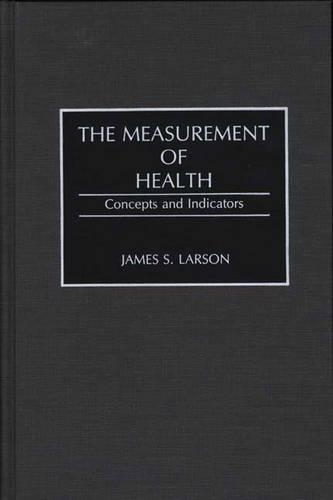
The Measurement of Health: Concepts and Indicators
(Hardback)
Publishing Details
The Measurement of Health: Concepts and Indicators
By (Author) James Larson
Bloomsbury Publishing PLC
Praeger Publishers Inc
21st May 1991
United States
Classifications
Tertiary Education
Non Fiction
362.1
Physical Properties
Hardback
192
Description
How can the various indicators of health, available through statistics, government publications, private surveys and other sources, be measured This and other questions are brought to light in James Larson's study of concepts in the health measurement of individuals and populations. This book is intended to provide a backdrop for future research into determining health care needs, while allowing for more efficient allocation of scarce resources by planners and administrators. The first chapter defines health by using five models, the two major ones being the medical and the holistic. The medical model is the absence of disease and disability, and the holistic generally defines health as physical, mental and social well-being. Chapters Two and Three discuss the statistical measurement of mortality and morbidity (illness or disability) by government and other agencies. International health measurement is the focus of the fourth chapter, which includes descriptions of World Health Organization activities in planning for health improvements worldwide and the lack of accurate health measurement in developing countries. Chapter Five discusses United States national health statistics gathering, while chapter Six analyzes the less sophisticated vital statistics methodologies used at the state and local levels. In the final chapter, Larson proposes indicators for international, national, state, and local levels, given the best possible data for health measurement. "The Measurement of Health" should be of value to health statisticians, scholars interested in health policy, students in courses concerning research methods in health, health services administrators, and health professionals.
Reviews
Larson (Why Government Programs Fail: Improving Policy Implementation, 1980) provides a concise, comprehensive work on the basic elements of measuring health. Recognizing that the measurement of health is affected by how it is defined within various cultures and for various purposes, Larson reviews definitions of health that will serve as the basis for the methods of measurement, which are expertly explained in the succeeding chapters. Each chapter offers a survey of methods beginning with those that are more traditional, and continues with new and innovative methods at the international, federal, state, and local levels. Larson's critical analysis of standard instruments, with emphasis on mortality, morbidity, and disability measures, clearly presents the purpose, structure, and effectiveness of each method. In conclusion, the author offers his own proposal for gleaning the best of these methods to develop a more effective system of health measurement. The addition of appendixes of measurement instruments and the extensive use of expert references enhance this excellent resource for students of policy development, research, and measurement related to health. Upper-division and graduate collections.-Choice
"Larson (Why Government Programs Fail: Improving Policy Implementation, 1980) provides a concise, comprehensive work on the basic elements of measuring health. Recognizing that the measurement of health is affected by how it is defined within various cultures and for various purposes, Larson reviews definitions of health that will serve as the basis for the methods of measurement, which are expertly explained in the succeeding chapters. Each chapter offers a survey of methods beginning with those that are more traditional, and continues with new and innovative methods at the international, federal, state, and local levels. Larson's critical analysis of standard instruments, with emphasis on mortality, morbidity, and disability measures, clearly presents the purpose, structure, and effectiveness of each method. In conclusion, the author offers his own proposal for gleaning the best of these methods to develop a more effective system of health measurement. The addition of appendixes of measurement instruments and the extensive use of expert references enhance this excellent resource for students of policy development, research, and measurement related to health. Upper-division and graduate collections."-Choice
Author Bio
JAMES S. LARSON is Associate Professor of Public Administration at the University of Arkansas. His previous publications include Why Government Programs Fail: Improving Policy Implementation (Praeger, 1980), and articles in Health Management Quarterly, the Journal of Health and Human Resources, and Public Health.
